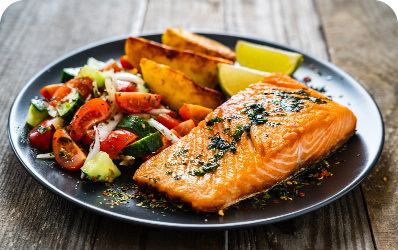Sources of DHA
HOW DO BABIES GET DHA IN BREAST MILK?
Breastfed babies get DHA from their mother’s breast milk, so the amount depends on mom’s nutrition.
DHA is found naturally in relatively few foods, and the highest levels are in fatty fish. If you’re breastfeeding exclusively, Health Canada recommends that you eat at least two 75 g (2.5 oz) servings of cooked fish per week. But not all fish contain the same amounts of DHA. Atlantic salmon, on average, provides about 5 times more DHA per serving than sole. If you eat less than 2-3 weekly servings of fatty fish (150 g – 225 g/week), it’s likely that your baby won’t get the recommended amount of DHA. Experts recommend⁑ that pregnant or breastfeeding moms consume at least 200 mg of DHA per day.
Other omega-3 fats are found in foods like flaxseed and walnuts, but only a small amount of these fats are converted to DHA when eaten. As you can see, it’s not always easy for your baby to get the DHA that helps nourish their brain. If you have trouble getting a recommended amount of DHA through your diet, talk to your doctor about taking a DHA supplement.
HOW DO BABIES GET DHA IN FORMULA?
DHA-enriched infant formulas, used for supplementing or exclusively, are an easy way to give your baby DHA. If you’re looking for a newborn or infant DHA formula, Enfamil A+® offers several DHA formulas to support your baby’s brain development including Enfamil A+ Neuropro, our closest formula to breastmilk ever.
Enfamil A+ Neuropro has both an expert-recommended level of DHA⁑ and our exclusive BIOPRO™ blend† including 2’-FL, for immune support. It’s also our closest formula to breast milk. No wonder it’s the #1 brand recommended by paediatrician.‡
HOW DO TODDLERS GET DHA?
Your toddler and kid may not be eating a recommended amount of DHA-rich foods.
An international expert group⁑ recommends that toddlers up to 24 months of age have 100 mg/day of DHA. While there are food sources for DHA, these are foods most toddlers and kids don’t—or won’t—regularly eat, such as Atlantic salmon and mackerel.
DHA-enriched toddler and kid drinks offer an easy way to add DHA to your child’s diet. DHA-enriched nutrition is a practical way to support normal brain development in children under the age of 3.
Choosing a Baby Formula
Choosing a Baby Formula
Enfamil A+ offers a full line of infant formulas and toddler drinks with DHA to support your child’s brain development needs—including Enfamil A+ Neuropro, our closest formula to breastmilk ever.
Interactive Feeding Guide
Discover recipes with DHA
† DHA supports normal physical brain development
‡ BIOPRO blend™ of PDX, GOS and 2'-FL
* Enfagrow is a nutritional supplement. Not intended for infants under 12 months.
** Premium Guarantee allows you to get a full $39.99 refund by your baby’s 3rd month, should you decide to breastfeed. Formula must be unused. Simply contact customer service for additional details.
*** Full-sized products and a maximum of $500 value offers are only included in the Premium membership.
**** Premium members get 10% off, equivalent to up to $60 savings. $60 is equal to 10% off a maximum order value of $600. Basic members get 10% off, equivalent to up to $20 savings. $20 is equal to 10% off a maximum order value of $200. The 10% off discount code is for one-time use.
⁑ Koletzko B et al. J Perinat. Med. 2008;36:5-14
Additional Sources:
2. https://fdc.nal.usda.gov/fdc-app.html#/food-details/175167/nutrients
3. https://fdc.nal.usda.gov/fdc-app.html#/food-details/174197/nutrients








